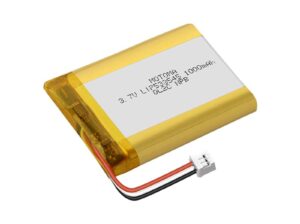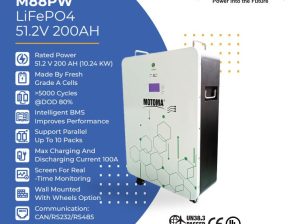The Common Causes of Lithium Polymer Battery Swelling You Need to Know
Have you ever experienced your lithium polymer battery swelling up out of nowhere? It’s a common issue among gadget enthusiasts and it can be both frustrating and dangerous. Lithium polymer batteries are the power source for most portable electronic devices but when they swell, it poses a risk of explosion or fire. In this post, we’ll discuss the common causes of lithium polymer battery swelling that every gadget owner should know to prevent such mishaps from happening. So, let’s dive in!
Introduction to Lithium Polymer Batteries
Lithium polymer batteries are a type of battery that has become increasingly popular in recent years, especially in portable electronic devices. These batteries have several advantages over other types of batteries, such as a higher energy density and a lower self-discharge rate. However, lithium polymer batteries can also be susceptible to a condition known as “swelling.” Swelling occurs when the battery’s internal chemical structure is damaged, causing the battery to expand. This can damage the device in which the battery is used, and can also be dangerous to the user.
There are several common causes of lithium polymer battery swelling. One is overcharging. When a lithium polymer battery is charged too rapidly, or when it is allowed to remain fully charged for extended periods of time, this can cause damage to the battery’s internal structure. This damage can eventually lead to swelling.
Another common cause of lithium polymer battery swelling is exposure to excessive heat. Heat can damage the battery’s internal structure and cause the formation of cracks or voids. These cracks and voids can allow electrolytes to escape from the cells, which can lead to swelling.
Manufacturing defects can also lead to lithium polymer battery swelling. In some cases, batteries may be shipped with damaged cells that are already prone to cracking and leaking. In other cases, manufacturing defects may not be immediately apparent but may still result in long-term damage to the battery’s internal structure.
If you suspect that your lithium polymer battery is swelling, it is important to stop using the device immediately and contact the manufacturer for instructions on how to proceed. Swelling batteries can be dangerous, so it is important to take proper precautions.
What is Battery Swelling?
When a lithium polymer battery swells, it means that the cells inside the battery are overcharged and causing the electrolyte to expand. This can happen for a number of reasons, but is most often caused by:
-Charging the battery too quickly
-Using a charger that is not compatible with the battery
-Leaving the battery charging for too long
-Exposing the battery to extreme heat or cold
If your battery begins to swell, it is important to stop using it immediately and dispose of it safely. Swelling batteries can be dangerous as they can leak electrolyte or even catch fire.
Common Causes of Battery Swelling
Lithium-ion batteries are becoming increasingly popular, but they are not without their problems. One of the most common issues with these batteries is swelling.
The battery cells in a lithium-ion battery are filled with a liquid electrolyte. This electrolyte is made up of a mixture of lithium salts and organic solvents. When the battery is charging, the lithium ions move from the negative electrodes to the positive electrodes. When the battery is discharging, the opposite happens and the lithium ions move from the positive electrodes to the negative electrodes.
This process is reversible, but it isn’t perfect. Over time, some of the lithium ions become trapped at either the positive or negative electrodes. This causes what’s known as “polarity reversal.” As more and more lithium ions become trapped, it becomes harder for them to move back and forth between the electrodes. This reduces the battery’s capacity and can eventually lead to swelling.
Polarity reversal isn’t the only cause of battery swelling, however. Another common cause is overcharging. When a battery is overcharged, it means that more electricity has been forced into it than it can safely hold. This excess electricity breaks down the electrolyte, which releases heat and gas. The heat can damage the cell walls, while the gas puts pressure on them. This can also lead to swelling.
In some cases, manufacturing defects can also lead to battery swelling. For example, if there are any voids or cracks in the battery cell, this can lead to an imbalance in the concentration of lithium ions. This can cause localized swelling and even short-circuits.
Finally, physical damage can also cause battery swelling. If a battery is dropped, bumped, or otherwise physically damaged, it can cause localized swelling or even permanent damage to the battery.
How to Prevent Battery Swelling
Lithium polymer battery swelling is a common issue that can occur in batteries of all types. While it’s not necessarily a cause for alarm, it’s important to understand the causes of battery swelling and how to prevent it from happening.
One of the most common causes of battery swelling is charging the battery too frequently. When you charge a lithium polymer battery, heat is generated which can cause the battery to swell. To prevent this, only charge your battery when it’s low on power and avoid charging it more than once per day.
Another common cause of battery swelling is exposure to extreme temperatures. Heat and cold can both cause the battery to swell, so it’s important to keep your battery away from direct sunlight or other sources of heat, and avoid storing it in extremely cold environments.
If you notice your battery beginning to swell, there are a few things you can do to mitigate the issue. First, stop using the device immediately and remove the battery if possible. Then, place the device in a cool, dry place out of direct sunlight and allow the battery to cool down. Once the swelling has subsided, you can slowly start using the device again but be sure to monitor the situation closely. If the swelling persists or gets worse, discontinue use and consult with a professional.
Signs Your Battery is Swelling
If your battery is swelling, it’s important to take action immediately. Swelling batteries can be dangerous and cause damage to your device. Here are some signs that your battery is swelling:
-Your device feels hot to the touch
-The battery case is bulging or bloated
-There is liquid leaking from the battery
-The battery life is reduced or the device won’t turn on
If you notice any of these signs, remove the battery from your device immediately and contact the manufacturer. Do not use the device until the manufacturer has repaired or replaced the battery.
How to Safely Dispose of a Swollen Battery
If you have a swollen battery, it’s important to dispose of it safely. Here’s how:
- Remove the battery from the device it’s in. If it’s in a phone or other portable device, power off the device first.
- Place the battery in a non-conductive container, such as a plastic bag.
- Take the battery to a local recycling center that accepts lithium ion batteries. You can also call your local waste management department to find out where to recycle batteries safely.
- Never throw a battery in the trash!
Conclusion
Lithium polymer batteries are powerful, lightweight and long-lasting but it is essential to know the common causes of swelling in order to properly maintain them. Overcharging and extreme temperatures can cause lithium polymer batteries to swell or even catch fire, so it is important that these issues are monitored closely. With proper monitoring and maintenance, you can ensure your battery will last for many years without any problems.
Comments (2)
You must be logged in to post a comment.



[…] Lithium Polymer batteries are rechargeable batteries widely used in various applications due to their high energy density, lightweight, and long cycle life. They are commonly used in portable electronic devices such as smartphones, laptops, and tablets, as well as in electric vehicles and renewable energy systems. Low Temperature LiPo Battery is a type of Lithium Polymer battery that has been designed to operate in low-temperature environments. […]
[…] common type of lithium-ion cell is the lithium cobalt oxide (LiCoO2) cell. These cells have a nominal voltage of 3.6 volts and are widely used in […]